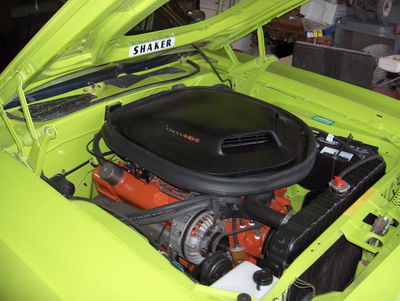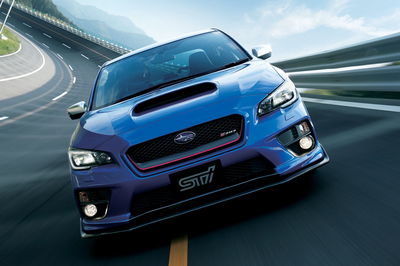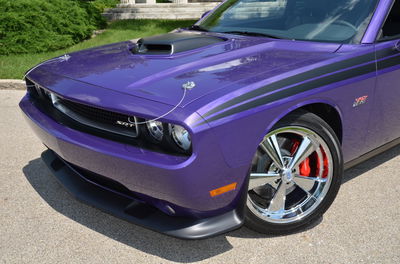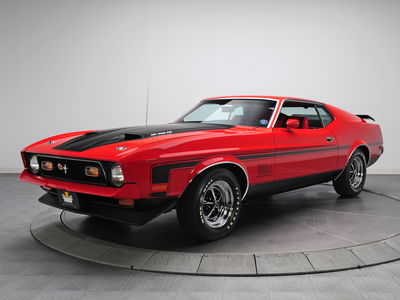What Is A Shaker Hood, And How Do They Work?

The hoods or bonnets of cars can take all shapes and sizes, with designs ranging from purely artistic curves to very much functional divots and scoops. In performance-orientated cars, airflow is usually the main factor when deciding upon a bonnet design due to the need for efficient cooling and large volumes of induction air to feed whatever behemoth of an engine is nestled under the hood.
Massive air scoops are therefore extremely common in the performance car sector, used to catch the fast moving air passing over the bonnet and force it in through the intake and air filter to the intake manifold. But there’s a specific form of integral air scoop that has been used on multiple legendary muscle cars that pushes the average bonnet scoop up a few notches of functionality.
It’s called a shaker hood (or shaker scoop) and instead of being part of the car’s bonnet, it is instead an air intake attached directly on top of the air filter (or air cleaner), which in many American muscle cars is positioned on top of the engine block. The name comes from the fact that the air intake shakes as the engine turns over, with the vibrations created from the reciprocal movements transmitting upwards and forcing the intake to tremor.
A shaker hood effectively works as a short ram intake which has a couple of benefits over a standard air intake system. Firstly, the distance the air has to travel before entering the engine’s cylinders is massively reduced due to the lack of long piping that is needed for a general air box system. This means that the intake air experiences much less air resistance as it enters the intake system, thus decreasing unwanted friction and allowing the air to pass smoothly and quickly into the intake with greater efficiency.
The second benefit is the fact that the larger volume of air capable of entering the engine repeatedly makes for an increase in power. As we all know, you need three basic things for combustion; oxygen, fuel and a spark. By maximising the influx of oxygen to the cylinders, the energy from each combustion cycle will be increased, thus making for a suitable gain in power.
The air will also not have a chance to heat up due to the shortened distance that is has to travel within the engine bay. This cool air is suddenly condensed as it enters the air intake constriction, further increasing the efficiency of the resultant internal combustion due to the large temperature difference between the intake air and the ignition spark.

Debuting in the Plymouth Barracuda and Dodge Challenger, the shaker hood quickly became synonymous with the legendary American muscle cars powered by the HEMI V8. The big-block engines produced a huge amount of vibration emanating up from the rudimentary OHV systems of the day, forcing the intake to hop and jump around the gaping hole cut in the bonnet to house the component. Chrysler therefore coined it as the “Incredible Quivering Exposed Cold Air Grabber”, but the petrolheads of the time quickly changed the long-winded trademark for the much cooler slang that lives on to this day.
Unfortunately, air intakes like this rely on the speed of the air entering the scoop to define their efficiency. And even then, the sheer amount of air that an internal combustion engine has to suck into itself for combustion means that the intake air never really gets the chance to reach any high levels of pressure before being forced through the intake manifold. So although they look cool and theoretically have a genuine function, power gains are minimal from such intakes and therefore they shouldn’t be seen as the holy grail of horsepower.

The HEMI V8 went through a bit of a slump in sales as fuel prices went through the roof in the 1970s and 1980s and as a consequence shaker hoods became less common, but Dodge decided to bring back that little taste of retro ‘Murica with its Challenger SRT10 concept back in 2008. Despite the main furore based around the Viper V10 under the bonnet, many keen-eyed fans spotted what seemed to be a shaker hood intake protruding from the depths of the engine bay.
Dodge then stayed true to its conceptual promise by introducing a shaker kit on the 2014 Challenger to sit atop the V8 powerplant once again. The massive popularity of the retro intake forced Dodge to then feature the shaker hood on its 2015 Challenger as well, with the package being available on all R/T, R/T Plus and 392 Scat Pack trims.

Other famous cars that featured such an intake include the Ford Torino, Ford Mustang Mach 1 special edition and the Pontiac Firebird and GTO, so it’s easy to see why Americans of a certain age get all wide-eyed over the shaker hood legend.
Although it may not have been revolutionary, the shaker hood definitely has its place in the progress in muscle car engineering back in the 1970s and despite power gains being minimal to say the least, the presence of an engine trying to seemingly rip itself free from its own mounts is a sight to behold.













Comments
Naca duct intakes should be next!
Good post but the Shaker intake was a name used only for MOPARs, the other systems were called RAM-Air especially for the GTO. And the shaker wasn’t used on the small-block, only on the 426 Hemi and 440-6 pack which were big-blocks, also (sorry for being so corrective) the vibration wasn’t because of the over-head camshafts (almost every V8 in that era was over-head valve, better known as cam in block) the vibration was because of the “lumpy” cams and the charge to the right at full throttle was because of the torque produced by the engine and the engine mounts of that era.
Sorry for being overcorrective but being a Muscle car nerd I need to clarify the facts but aside that, awesome post thanks from bringing Muscle facts and info to CT.
I do not need to know what it is and how it works, I just know that I want and need one…
“Most bonnet scoops form a funnel for the air to stream into the air intake, rather than being integral to the entire powertrain beneath”
And you use an Impreza to illustrate that?
The scoop feeds the intercooler… not the intake.
Finally someone who knows it!
“The small-block engines produced a huge amount of vibration emanating up from the rudimentary overhead camshafts of the day”
Your attempt to trash pushrod engines failed and you just ended up talking bad about OHC engines lol
I believe the first car to have one was an Australian falcon.
I love the shaker hood. To me it’s almost the definition of muscle cars
The biggest problem of CT informative articles is factual accuracy. We all know the subaru scoop is not an air intake, it is an air passage to keep the intercooler cold. Then there is a ton of inaccuracy and lie in the origins of the name and the brand names as mentioned by CTzen ElTamaleriDeSayula. The second biggest problem is grammar…
New school shaker hoods aren’t air intakes anymore lift the hood and you’ll see a cold air intake on the right side behind the headlight.
Christian Strobel - Good article but….
The hemi was certainly not a small block at 7.0 liters. It was based off the 383 and 440 big blocks with the distributor in the front
“Rudimentary overhead camshafts” All Mopar with shakers were pushrod engines not OHC. The word you’re looking for is overhead valve.
“Rudimentary cam design” is not to blame for the shake. These engines had advanced high performance cams from the factory which aren’t efficient at low engine speeds and run rough. Has to do more with the limitations of carburetors as cammed FI cars don’t really shake
Pagination